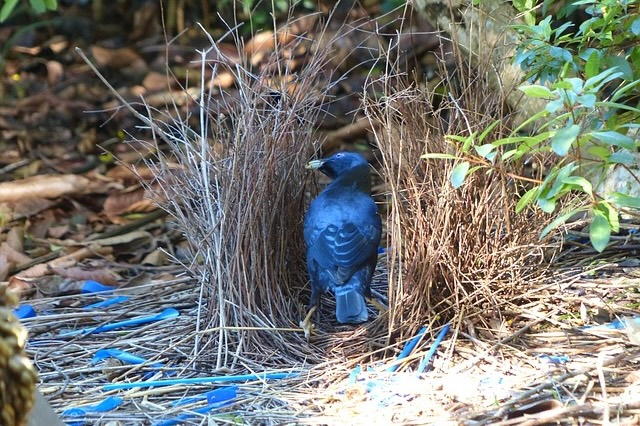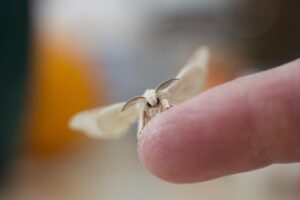10 Stunning Natural Homes That Weren’t Built by Humans
The natural world never fails to remind us just how outmatched we are by other species. Sure, humans have built towering cities, sprawling bridges, and intricate machines, but take away our technology, and suddenly, we’re barely capable of the essentials—finding food, building shelter, or even raising offspring without a mess.
Meanwhile, across forests, oceans, and underground labyrinths, creatures engineer marvels that put our so-called brilliance to shame. They construct homes with impeccable efficiency, balance, and sustainability—no blueprints, no heavy machinery, just instinct and mastery refined through evolution.
Let’s take a moment to set aside our ego-driven innovations and explore ten awe-inspiring structures built by nature’s finest architects. Prepare to be amazed, and maybe, just maybe, a little humbled.
10. Bagworm log cabins
Most butterflies and moths spin their cocoons from silk, but bagworm moths? They’re the ultimate DIY architects. Instead of relying on just one material, their larvae scavenge plant matter—leaves, twigs, even seeds—to craft their signature “bags.” And oh, the styles vary wildly across species. Some look like feathery pouches woven from stork’s bill seeds, while others dangle like tiny, lumpy sacks.
But the real showstoppers are the ones that build spiraling log cabins. A study in India examined 42 of these structures by Clania crameri larvae and found something wild: each stick is deliberately chosen. These little builders aren’t just piling debris—they’re engineers, handpicking twigs of specific lengths to create that graceful, tapering spiral.
Here’s the kicker: they spend almost their entire lives on this project. For what? The males eventually emerge as fuzzy, black-winged moths, but the females? They never leave. After a lifetime of construction, their bodies dissolve into a pile of eggs, ensuring the next generation continues the legacy.
Nature’s creativity never disappoints—who knew a bug’s condo could be this impressive?
9. Caddisfly submarines
Caddisflies—also called sedge flies—might look like small, hairy-winged moths, but their real magic happens underwater. As larvae, these unassuming insects transform into master builders, crafting intricate protective cases from silk, pebbles, sand, and bits of plants. Each species has its own signature style—some make smooth tubes, others jagged little fortresses—so while adult caddisflies can be tricky to distinguish, their larval creations are like tiny, wearable ID cards.
Most of these aquatic architects prefer life in rivers and streams, but there’s one rebel in the bunch: Enoicyla pusilla, the “land caddis.” Found in the damp leaf litter of England’s West Midlands, it’s the only known caddisfly that ditches the water entirely. Every other species? Strictly submarine.
What’s even wilder? Some larvae build mobile homes, dragging their cases around like hermit crabs, while others anchor themselves in place. Imagine spending your childhood constructing a custom shell, only to shed it all when you finally take flight. Nature’s version of growing out of your DIY phase? Absolutely.
8. Ovenbird adobe abodes : Nature’s Tiny Mud Architect
Most birds are content with twiggy nests or cozy tree hollows—but not the ovenbird. This North American songbird earns its name by crafting adobe domes so sturdy, they look like miniature Dutch ovens (if you use your imagination). Over two grueling weeks, the bird molds roughly 2,000 mud pellets—weighing up to 10 pounds—into a perfect spherical nest. It’s not just mud, though: grass lines the interior for comfort, while plant fibers and even dung reinforce the structure.
But the real genius is the fortified entrance. Instead of a gaping hole, the nest has a side door with a sneaky curved wall inside, forcing predators to navigate a tight, twisting path. Combine that with the rock-hard mud, and you’ve got a near-impenetrable fortress.
And here’s the kicker: ovenbirds don’t stop at one design. Some opt for pre-dug cavities, like abandoned woodpecker holes or deep burrows (did they dig them? Mystery unsolved). Others build thorny dome nests, weaving in sticks, feathers, and—wait for it—snakeskin for extra intimidation.
Most birds keep it simple. The ovenbird? It’s out here reinventing avian real estate, one mud brick at a time.
7. Bowerbird theme parks

Native to Australia and New Guinea, bowerbirds have the surprising distinction of being second only to humans in the adornment of their structures. In fact, their bowers (walls of sticks bent inwards to form arched shelters with cleared ground in front) have even drawn comparisons to Disney World. Just as the upper bricks of Sleeping Beauty’s Castle and the buildings of Main Street are smaller than at ground level to make everything look taller, male bowerbirds use forced perspective to make their bowers look smaller (and themselves bigger, according to one theory) to prospective female mates in the air.
The similarity to Disneyworld doesn’t end there. To attract mates, bowerbirds also fill their yards with plastic tat and mass-produced garbage: marbles, ring pulls, duct tape, bra straps, ribbons, pegs, glass, wrappers, and even syringes (always with the largest items toward the back). One bower was found to have bottle caps arranged in an arc around a plastic doll splayed in the center, “eyes wide and mouth open in a plastic scream.”
They also include plenty of natural materials—feathers, stones, shells, leaves, flowers, beetles’ body parts, and so on. But, interestingly, bowerbirds living close to humans show a preference for our trash because they know its color lasts longer. This is important. The objects selected for display are meticulously color-coordinated. Blue is the favorite of the satin bowerbird, while the great bowerbird likes purple, red, and green.
6. Sociable weaver apartments
Move over, big-city architects—the sociable weaver has been engineering avian mega-cities for centuries. These sparrow-sized birds, found in the Kalahari Desert, don’t just build nests—they construct massive thatched condos, housing up to a hundred families in a single, sprawling structure. Picture a haystack dangling from a tree, but with individual “apartments” (four to six inches wide) lined with fluffy cotton, fur, and grass for maximum comfort.
A Fortress of Feathers and Teamwork
- Security first: Entrance tunnels stretch up to 10 inches and are lined with spiky straw to deter invaders.
- Prime real estate: They pick smooth-trunked trees or even telephone poles to foil snakes and honey badgers. (Though cheetahs and eagles still crash the rooftop for the view.)
- Eco-friendly perks: Their droppings fertilize the soil, boosting leaf growth—free shade and snacks for giraffes and antelopes.
The Original Bird Airbnb
Sociable weavers don’t just house their own—they’re generous landlords. Extra chambers host pygmy falcons, lovebirds, and finches, creating a bustling, multi-species neighborhood. The perks? More eyes watching for danger and intel on new food sources.
Climate-Controlled Living
- Summer: Birds chill in the cooler outer rooms.
- Winter: Everyone huddles in the toasty center.
- Fledglings: Raised by the whole colony, they shuffle between chambers like teens upgrading from a childhood bedroom.
Some nests last over 100 years—though the nonstop construction chatter and multi-ton weight can eventually topple their tree. Talk about a housing crisis!
5. Agglutinated foraminifera tests
If you’ve heard of agglutinated foraminifera before, give yourself a pat on the back. These single-celled microorganisms live more than six miles (10 kilometers) under the sea. Specifically, they inhabit the Mariana Trench, on what’s known as the Challenger Deep—which, though it sounds like the name of a submarine, is the deepest surveyed part of the seabed. In fact, it lies in the hadal zone (named for the Greek underworld), far beyond the previously thought deepest part of the ocean, the abyssal zone. You get the point, it’s a deeply inhospitable environment. And there’s not a whole lot to build with. Everything down there breaks down into clay, the smallest soil particle—which isn’t much use underwater, let alone 12,400 tons per square meter of it. It’s no good whatsoever for agglutinated foraminifera, which build their shells out of minerals like calcite, silica, and quartz.
In 2010, however, researchers were surprised to find specimens from the Challenger Deep with beautifully formed shells—or tests, as they’re called—of various minerals, including quartz and calcite. These tests are presumed to be formed (or agglutinated) from the sunken, decomposed remains of coccoliths (calcium carbonate-plated algae) and phytoplankton from the sea’s sunny surface. In other words, they build their homes from what’s called ‘marine snow’, the matter that sinks down from above, “rather like manna from heaven.”
As for the shells themselves, they come in different designs. Some are spirals, like tiny snails, while others are tubular with chambers in a row.
4. The Underground Metropolises You Never Knew Existed: Prairie Dog “Cities”
Most of us think of squirrels as tree-dwelling nut-hoarders, but prairie dogs—their ground-loving cousins—build something far more astonishing: massive subterranean cities. Forget tiny burrows; these rodents engineer sprawling, organized networks that rival human megacities in scale and complexity.
The black-tailed prairie dog, for instance, doesn’t just dig holes—it constructs entire towns with distinct neighborhoods. These aren’t random tunnels but carefully designed systems with dedicated entrances (marked by mounds of dirt), guard posts for spotting predators, separate sleeping chambers, and even communal toilets. The deepest tunnels house nurseries, keeping pups safe while adults socialize aboveground with affectionate nuzzles.
But here’s where it gets mind-blowing: their cities can grow unimaginably large. One record-breaking town spanned 25,000 square miles—about a tenth of Texas!—and housed an estimated 400 million prairie dogs. To put that in perspective, that’s more residents than Tokyo, Shanghai, New York, and 15 other mega-cities combined. Imagine all those humans replaced by chirping, burrowing rodents, and you’ve got a prairie dog “gigacity.”
Sadly, humans wiped out 98% of them last century, branding them as pests. Yet their surviving towns remain marvels of animal engineering and social structure. They’re even multicultural, sharing tunnels with snakes, owls, and ferrets—unlikely roommates in this underground universe.
Next time you see a grassy field, remember: beneath your feet could lie a vanished metropolis, proof that nature’s architects sometimes outdo our own.
3. Termite mega-skyscrapers
In Australia’s Northwest Territory, much of the dry plain landscape is dominated by the mounds of two termites. One is the compass termite, whose nests can reach heights of more than 10 feet and are built narrower along the north-south axis to avoid too much exposure to the sun.
The other is the cathedral termite, whose nests tower above the ground (and any passing mammals) at heights of 15 feet or more. These are the biggest skyscrapers in the world. By far. If the millions of termites inhabiting them were our size, the mounds themselves, scaled up proportionally, would be taller than three Burj Khalifas—and in some cases more than five!
Both the compass and cathedral termites’ mounds can last for a century, which, remarkably, could also be the lifespan of their queens. Again, scaling up for humans, this means that both queen and tower might last seven millennia—despite being formed from just saliva, sand, and dung.
Inside, everyone has a purpose. Deep inside are the reproductives, the so-called queen and her successors, as well as the king that fertilizes them. Then there are the soldiers, the defenders of the mound. In the case of cathedral termites, these are ‘nasute soldiers’, meaning they have a long nose-tube specially adapted for squirting sticky saliva at invaders. After them, and most numerous of all, are the workers—whose job is to build and maintain the nest, as well as to feed and tend the young and reproductives. They rarely leave the darkness of the city.
2. Ant empires
Sadly, the only way for humans to view the beauty of an ants’ nest is to fill it with plaster, hot wax, or molten metal, killing every last one of its occupants. The resulting cast, though it’ll cost you your soul, can be excavated and studied in detail. In this way, scientists have found a remarkable degree of planning and consistency in ant nest construction—which is all the more remarkable given they build in the dark without a leader or plan, and ants working on one side have no means of communicating with ants on the other (no means obvious to us relatively unevolved apes, that is).
Really, ants work much like cells in an organism—and these organisms, the colonies, can get pretty big. Nests belonging to the same species in any given area tend to merge together in “vast territorial systems” sometimes numbering hundreds of interacting colonies.
Nest features typically include food storage chambers, brood chambers (for eggs and the young), the queen’s chamber (at the heart), and waste disposal chambers (on the outer edge) for the deposit of dead ants and exoskeletons. These are joined by angled, vertical, or even spiraling shafts, which also provide ventilation. The variable depths and sizes of chambers provide the range of microclimates ant colonies need, particularly specialist species like those that farm fungi. They navigate their nests by chemical “signage”, similar to how they get around outside.
1. The Genius of Bees: Nature’s Master Architects

We often praise human engineering, but honeybees put us to shame. These tiny insects don’t just make honey—they construct mathematical marvels with nothing but wax and instinct. And the way they do it? Absolutely mind-blowing.
Take their honeycombs, for example. Each cell is a perfect hexagon, fitting seamlessly into a flawless grid—no measuring tools, no blueprints, just pure biological precision. Even more astonishing? Bees build from opposite sides of the comb, meeting in the middle with near-magical accuracy. Charles Darwin called it the “most wonderful of all known instincts,” and it’s easy to see why.
But here’s the kicker: they’re not just rigid little robots. Studies show that bees adapt on the fly, tweaking shapes when needed. Some cells become pentagons or heptagons to fix errors, and they even adjust angles to keep the structure stable. As one entomologist put it, “A simple robot could never recover from mistakes this smoothly.”
What’s really wild is that every bee has a role, yet there’s no boss shouting orders. They just know how to work together, fixing imperfections as they go. It’s not just instinct—it’s collective intelligence at its finest.
























